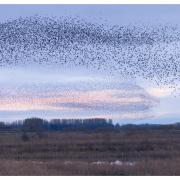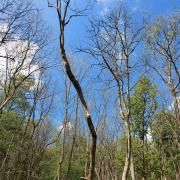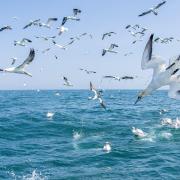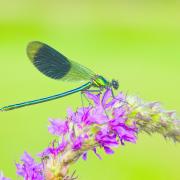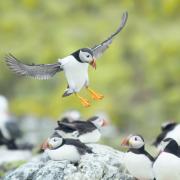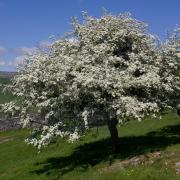Every year, the German Shorthaired Pointer Club holds a grouse pointing test on Haworth Moor that few ever get chance to witness. Ryan Kay and his dog Mollie go along.
Whenever I tell anyone that I’m taking part in a pointing test on the Yorkshire Moors, I get the same reaction: ‘You’re going to point at things on the Yorkshire Moors? And get marked for it?’ Well, not quite. Actually it’s my dog, Molly, who will be doing the ‘pointing’. Specifically, she’ll be ‘pointing’ at grouse.
Molly is a Hungarian Vizsla and — along with breeds such as the Weimaraner, Large Munsterlander, Italian Spinone and the German Shorthaired Pointer — is a Hunt Point Retrieve gundog or ‘HPR’ for short. Today, Molly and I are attending an annual grouse pointing test on Haworth Moor, organised by the German Shorthaired Pointer Club, with the kind permission of Mr JD Standevan and the Haworth Moor Syndicate Shoot. Apart from the experience grouse pointing tests give young HPR dogs (who may then be used, for real, during shooting season); they also offer an exciting way to see our native game bird.
Grouse shooting is a familiar sport, of course, but grouse pointing tests are much rarer. In fact, only around half a dozen meetings for the Hunt Point Retrieve group take place across England each year, with at least three of them on Yorkshire moorland.
Although those in the shooting field have sometimes never heard of pointing tests, they occur all over the country, mainly in the spring, with dogs run on fields of winter wheat or oil seed rape in search of pheasant and partridge. As these tests are only scheduled out of the shooting season, no shotguns are needed. The aim is for the dogs purely to find ‘game’ and ‘point’ it — and is therefore a good way to assess and evaluate the potential of each pointing dog.
A dog ‘on point’ is that famously photogenic pose of standing rigid, slightly aslant and with a front paw held up off the ground, his nose ‘pointing’ to the exact location of the birds.
The dog cannot actually see the grouse while he does this; pointing is done solely on scent. It’s pure instinct for a Hunt Point Retrieve dog.
Meanwhile, the grouse activate their defence mechanism and freeze, convinced that they can’t be detected if they remain still. The dog must remain locked in the ‘pointing’ position until the handler comes alongside and encourages him to run at the birds and flush them into the air. Afterwards, the dog must then be steady and immediately sit.
We meet early in the heart of Bronte Country. It’s the end of July and we’re all wearing big coats (some with handy hip flask pockets containing even handier hip flasks). People have travelled with their dogs from all around the country to be here.
At grouse pointing tests, dogs are graded ‘excellent’, ‘very good’ or ‘good’ depending on how well they’ve proved themselves. Usually, at about this time, butterflies are playing havoc in my stomach as I anticipate the prospect of Molly and I gaining a ‘grade’. (Molly, for her part, takes all such tests in her stride.)
Today, though, I can relax as we’re third reserve on the order of running and — with 15 dogs in total — we won’t be taking part. That’s fine, though. I can sit back and gain more experience from a spectator’s viewpoint.
We gather, and are introduced to straight-talking Yorkshireman Paul Thurtle, gamekeeper of the moor for the last 13 years, and his right-hand man and Joint Master of the Airedale Beagles, Paul Osbaldiston.
The judges explain their expectations from dogs and handlers. Although pointing tests are a very friendly and relaxed affairs, they are still serious enough that any dogs out of control are eliminated (with sheep grazing across the entire moor, dogs must respond to the handler). The main instruction from Judge Irmgard Alcock, however, is: ‘Enjoy yourselves — and let your dogs work.’
And work they do. Dogs are run individually into the wind, for not less than 10 minutes and are required to ‘quarter the ground’ — that is, to run out continuously from left to right, some 100 yards either side of the handler, always turning into the wind. That way they can cover vast areas and the scent of grouse will be sent directly to them. All the dogs running today are German Shorthaired Pointers. These are the most popular HPR breed in the country, prove themselves time and again in the shooting field and provide real spectacle as they work our Yorkshire moorland.
Paul Thurtle sees pointing tests as a chance for young dogs to obtain valuable know-how under relaxed conditions, as opposed to the more strict setting on a shooting day. But the tests have another benefit. They also provide Paul with information about the red grouse population in the area because, once the birds are flushed into the air by the dogs, they can be counted. Moorland gamekeepers would usually employ handlers with dogs or use their own dogs to help count the grouse in this way.
As we’re guided higher up, the Bronte moorland presents its spectacular views. We’re not alone up here and tourists and ramblers often cross our path. There’s a little grumble from the next dog handler as two walkers cross his potential run. ‘It’s fine!’ says Paul. ‘Footpaths are everywhere and they have the right to roam.’ The ramblers turn out to be Italian tourists and they ask the way to Bronte falls in broken English. Paul does his best to help — and they do their best to understand his broad Yorkshire accent. Then the test continues.
I’ve often thought there are three types of dog owners. There are dog lovers, dog handlers and dog lovers that know how to handle a dog. The people taking part in this test fall into the latter category and it’s events like this one which will improve their handling abilities, with valued feedback always given from the experienced judges.
At the end of the day we gather back at the shooting huts for tea (hip flasks now empty) and flapjack. Certificate presentations for graded dogs and a verbal critique from the judges round up a fabulous day and, although I’ve not been in the running order, Paul’s kindness extends to allowing Molly a run, un-judged, ‘off the record’. It’s not the best she’s ever run and there are no grouse on our patch but I relish the opportunity and we both enjoy the experience. It’s a real privilege.










